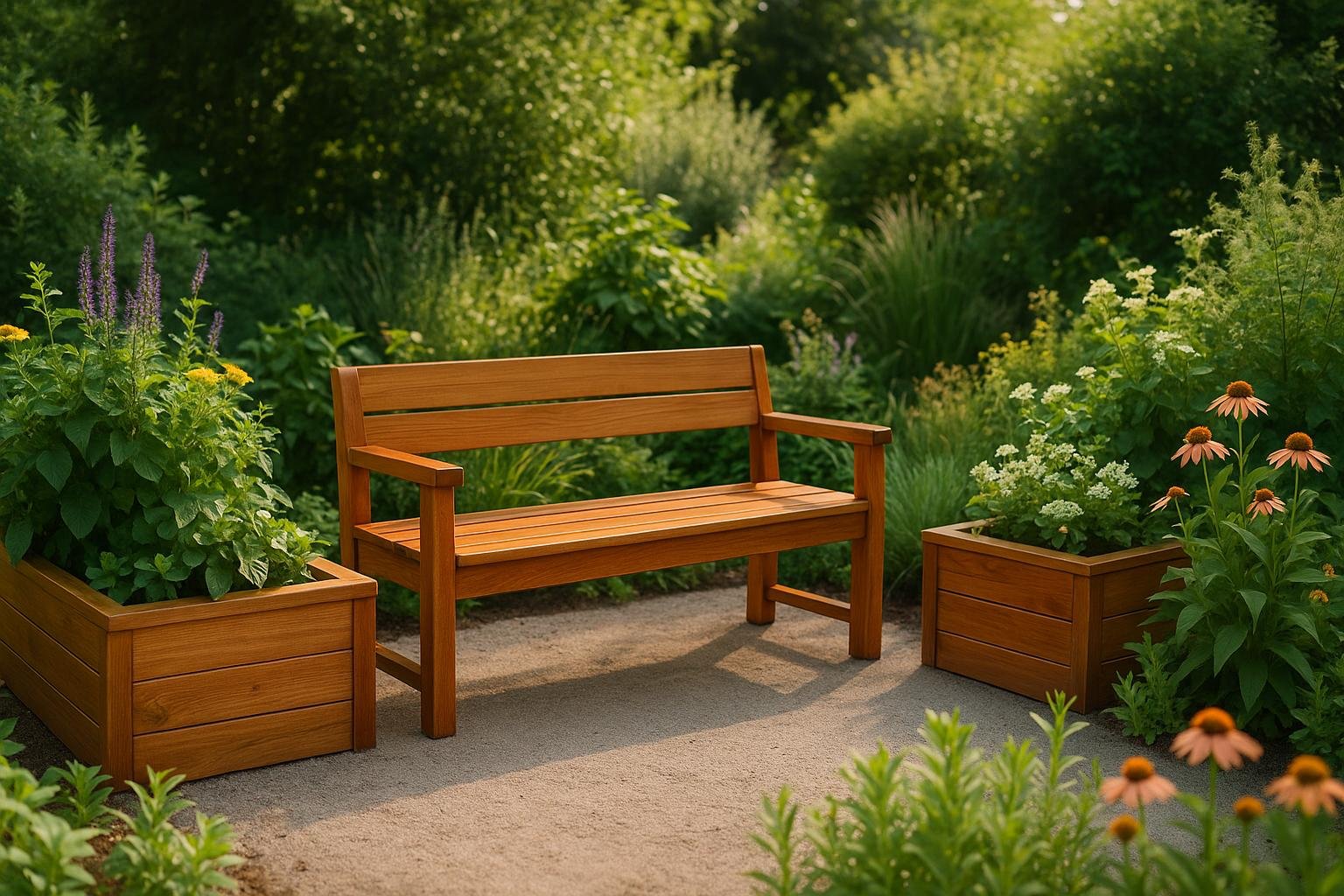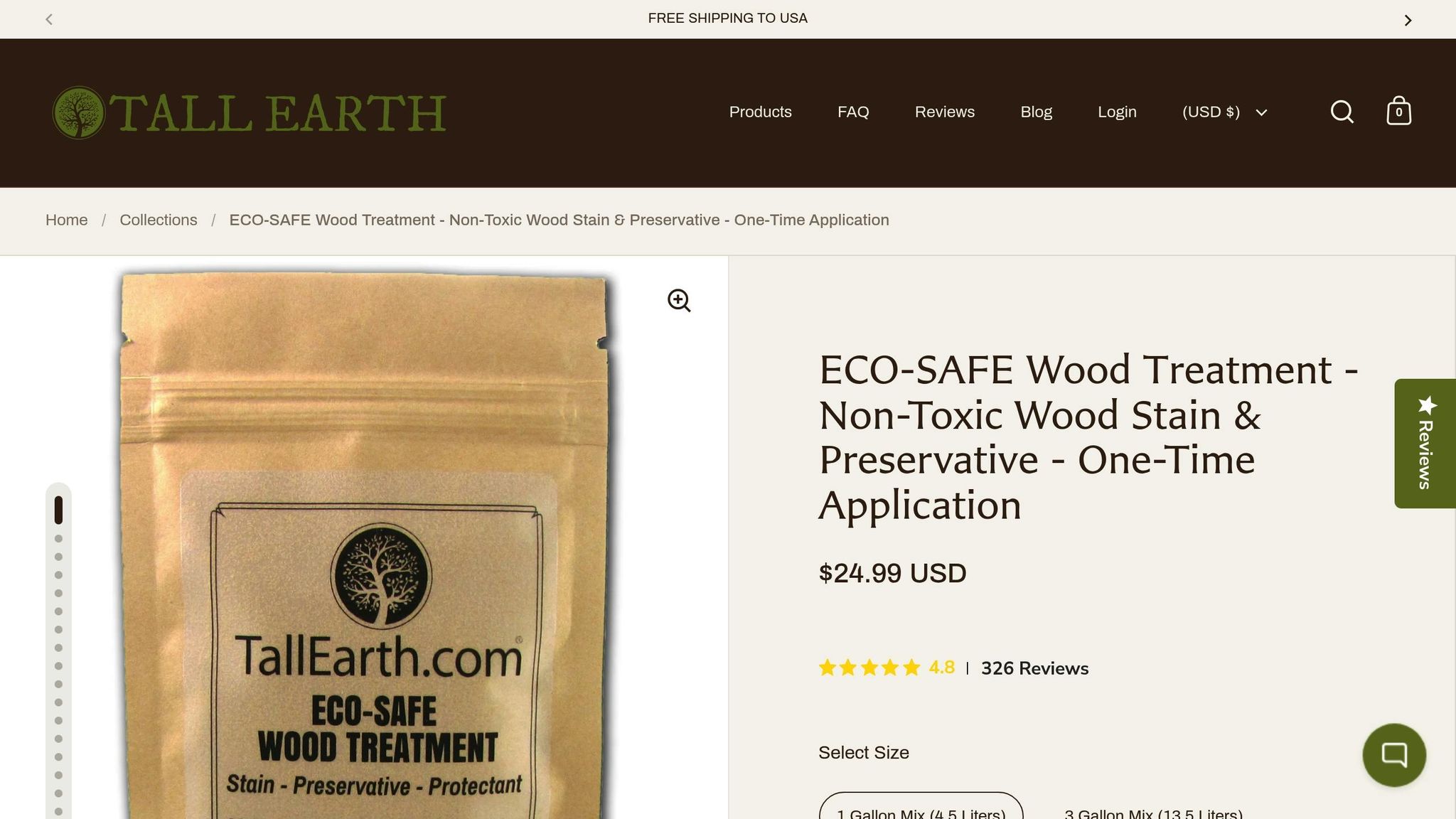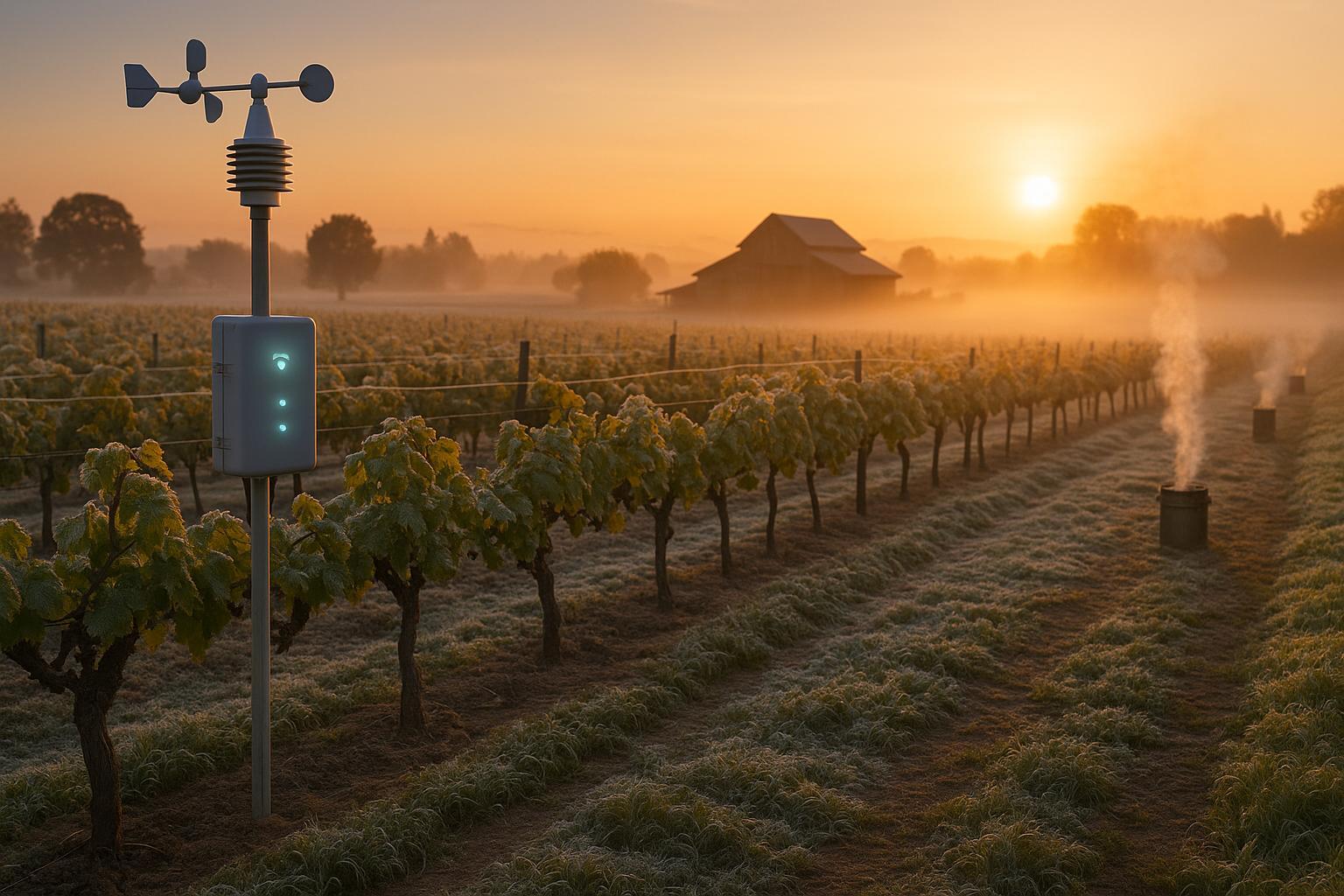Natural Wood Treatments for Sustainable Garden Design

Natural wood treatments are a great way to protect garden wood while keeping things eco-friendly. Here’s a quick summary of six natural options and their key features:
- Tung Oil: Water-resistant, durable, and food-safe. Best for cedar, redwood, and oak. Needs 3–5 coats and regular upkeep.
- Linseed Oil: Deeply penetrates wood, food-safe, and budget-friendly. Works well for raised beds and planters.
- Beeswax: Adds a natural sheen, repels water, and is non-toxic. Ideal for partially sheltered furniture and decorative elements.
- Hemp Oil: VOC-free, hypoallergenic, and great for soft woods like pine. Perfect for tool handles and food-safe applications.
- Milk Paint: Biodegradable and colorful with a matte finish. Best for furniture and decorative features.
- ECO-SAFE Treatments: Long-lasting, low-VOC, and versatile. Great for raised beds and sun-exposed furniture.
Quick Comparison
| Treatment | Moisture Resistance | UV Protection | Durability | Food Safety | Best Uses |
|---|---|---|---|---|---|
| Tung Oil | Excellent | Moderate | 1–3 years | Yes | Outdoor furniture, beds |
| Linseed Oil | Good | Low | 6–12 months | Yes | Planters, raised beds |
| Beeswax | Moderate | Limited | 3–6 months | Yes | Decorative elements |
| Hemp Oil | Good | Minimal | 12 months | Yes | Tools, food-safe uses |
| Milk Paint | Poor | Moderate | 2–3 years | Yes | Furniture, accents |
| ECO-SAFE | Good | High | 2–3 years | Varies | Raised beds, furniture |
Choose the treatment that best fits your garden’s needs and climate. For high-moisture areas, tung oil and ECO-SAFE treatments are great. For food-safe projects, linseed or hemp oil works well. Regular maintenance ensures long-lasting results.
Treating Wood with Linseed Oil & Pine Tar (Talks w/ an Expert)

1. Tung Oil
Tung oil comes from the seeds of the tung tree (Vernicia fordii), a species native to China. Known for its historical use as a finish and waterproof coating, tung oil provides excellent water resistance and durability, making it a great option for outdoor garden features. Plus, it enhances the natural beauty of wood by highlighting its grain.
This oil works by penetrating deep into the wood fibers, creating a strong, additive-free barrier. Pure tung oil contains no volatile organic compounds (VOCs), making it a food-safe and eco-friendly choice for outdoor projects.
It pairs especially well with dense, rot-resistant woods like cedar, redwood, and white oak, where it not only protects but also brings out the wood's natural grain.
For easier application, consider a "Half & Half" blend. This mixture of pure tung oil and citrus solvent allows for quicker absorption, faster drying, and a smoother finish - all while maintaining the protective qualities and food safety of pure tung oil.
To apply, start with clean, dry wood. Use a natural bristle brush or a lint-free cloth to apply thin coats. Allow 24–48 hours of drying time between coats, and lightly sand the surface between applications to improve adhesion. For the best results, apply 3–5 coats and let the finish cure completely for 15–30 days before exposing it to outdoor conditions. Regular upkeep will ensure long-lasting protection.
While tung oil does require more drying time between coats, this is a small trade-off for its durable protection and environmentally friendly nature. Up next, we’ll look at another natural treatment option to keep the sustainable design conversation going.
2. Linseed Oil
Linseed oil, derived from flax seeds (Linum usitatissimum), is a time-tested solution for protecting garden wood. It seeps deeply into the wood, creating a barrier against moisture while enhancing the natural grain.
This oil comes in two varieties: raw and boiled. For garden projects, especially those involving food-growing structures, raw linseed oil is the go-to choice. It’s completely natural and food-safe, free from metallic drying agents or harmful additives. To get the most out of linseed oil, it’s important to apply it correctly.
Here’s how to use it:
-
Prepare the Surface
Start by cleaning the wood, sanding it, and removing any old finishes to ensure the oil penetrates effectively. -
Apply the Oil
Use a natural-bristle brush or a lint-free cloth to apply the oil along the wood grain. Let it soak in for 30-60 minutes, then wipe off any excess.
Linseed oil is especially useful for garden features like raised beds and planters. Its food-safe properties mean it won’t leach harmful chemicals into the soil, making it perfect for edible gardens.
| Wood Type | Works Well With Linseed Oil? | Best Uses in the Garden |
|---|---|---|
| Cedar | Excellent | Raised beds, outdoor furniture |
| Redwood | Excellent | Decorative elements, garden structures |
| Oak | Very Good | Heavy-duty garden features |
To keep the wood protected, reapply linseed oil every year - or more frequently if the weather is particularly harsh.
Safety Tip: Be cautious when handling oil-soaked rags. Linseed oil generates heat as it dries, which can lead to spontaneous combustion. To avoid this, lay the rags flat outside to dry or store them in a metal container filled with water.
This finish is microporous, allowing the wood to "breathe" while still providing excellent water resistance.
🚀 Ready to Reinvent Your Garden?
Join thousands of homeowners who have transformed their gardens using our AI design tool. Upload one photo to explore endless possibilities.
Get your AI garden designs →3. Beeswax
Beeswax, a natural product made by honeybees, creates a breathable layer that highlights wood's natural charm. It helps repel water while maintaining the wood's moisture balance. Plus, it's non-toxic and safe for food, making it a great option for garden projects where plants and wildlife coexist.
Here’s how to use beeswax effectively:
- Preparation: Start by cleaning and sanding the wood thoroughly. Make sure the surface is dry, as this helps the wax adhere better. Warming the wood slightly can also aid in absorption.
- Application: Melt pure beeswax and mix it with a natural carrier oil, like linseed or jojoba oil, in equal parts (50/50). This softens the wax, making it easier to apply. Use a lint-free cloth to spread thin, even coats. Let the mixture sit for 15–30 minutes to soak in, then buff off any excess.
While beeswax gives wood a natural sheen, offers UV protection, resists mold, and is food-safe, it does have some limitations. It needs reapplication every 6–12 months, can soften in extreme heat, and isn’t ideal for wood in direct ground contact. For better durability, especially for garden furniture exposed to sunlight, many woodworkers mix beeswax with carnauba wax. This combination boosts heat resistance and extends the finish's lifespan.
Beeswax works particularly well for garden projects like raised beds, trellises, arbors, partially sheltered furniture, potting benches, and even tool handles or storage units. Applying several thin coats instead of one thick layer enhances both moisture resistance and penetration.
This natural finish strikes a nice balance between protection and aesthetic appeal, setting the stage for comparing it with other environmentally friendly wood treatments.
4. Hemp Oil
Hemp oil offers a natural and eco-friendly way to treat wood, making it a great choice for sustainable garden projects. Extracted from hemp seeds, this oil protects and nourishes wood without releasing harmful volatile organic compounds (VOCs) into the environment.
It works especially well on softer, porous woods like pine, as it penetrates deeply to enhance the natural grain. Plus, its food-safe and hypoallergenic qualities make it ideal for garden features that come into contact with soil or food.
Here’s a quick look at what hemp oil brings to the table:
| Characteristic | Benefit for Garden Features |
|---|---|
| Penetration | Deeply nourishes wood fibers |
| Finish | Soft, matte look that highlights the grain |
| Safety Profile | Safe for food contact and hypoallergenic |
| Environmental Impact | Non-toxic and VOC-free |
| Maintenance | Needs occasional reapplication for best results |
To apply, start by cleaning and drying the wood thoroughly. Use a lint-free cloth to apply thin layers of hemp oil, following the grain of the wood. Be sure to buff off any excess oil to prevent a sticky residue.
Hemp oil is particularly effective in humid conditions, but outdoor use - especially in areas prone to harsh weather - may call for more frequent reapplications. Pay close attention to edges and seams where moisture tends to collect for better long-term durability.
This treatment is perfect for garden tool handles, raised beds, planter boxes, furniture, and even decorative trellises. It slightly darkens the wood while enhancing its natural texture, maintaining a simple, organic look that works beautifully in eco-conscious garden designs.
Regular reapplication in changing weather conditions keeps the wood protected, making hemp oil a reliable and sustainable option to consider as we explore more eco-friendly finishes in the sections ahead.
sbb-itb-4d6a8dd
5. Milk Paint
Milk paint is a natural wood treatment made from milk protein (casein), lime, clay, and natural pigments. It offers an environmentally friendly option with a soft, matte finish. Because it’s biodegradable, free of VOCs, and breathable, it allows wood to expand and contract naturally, helping to prevent rot and decay.
| Application Area | Best Practices | Maintenance Needs |
|---|---|---|
| Raised Beds | Apply 2–3 thin coats and seal with food-safe oil | Recoat every 2–3 years |
| Garden Furniture | Sand between coats for a smooth finish | Inspect sealer annually |
| Decorative Features | Use multiple layers for added depth | Touch up as needed |
| Trellises/Arbors | Apply during dry weather | Reapply sealer every 1–2 years |
To apply milk paint, start by cleaning and sanding the wood. Mix the paint powder with water, letting it sit for 15–20 minutes to reach the right consistency. Then, use a natural-bristle brush to apply thin, even coats along the grain. For outdoor projects, finish with a protective topcoat using sealers like pure tung oil, hemp oil, or beeswax.
While milk paint works beautifully for many garden projects, it’s not the best choice for areas exposed to constant ground contact or continuous moisture. It costs about $20–$30 per quart, which covers approximately 70–80 square feet. Though the upfront price is higher than traditional finishes, its eco-friendly benefits make it worthwhile.
This paint is ideal for garden features like benches, planter boxes, and decorative accents, offering a rustic charm while maintaining the wood's natural appeal. Its non-toxic composition makes it a safe choice for children’s play equipment and edible garden areas.
Maintenance is straightforward, usually requiring touch-ups or reapplications every 2–3 years in outdoor conditions. With proper care, milk paint provides a long-lasting, sustainable solution that combines natural beauty with safety - perfect for eco-conscious garden designs.
6. ECO-SAFE Wood Treatment

ECO-SAFE wood treatments rely on natural ingredients and low VOCs to protect garden structures while being gentle on soil and plants. Similar to tung oil and linseed oil, these treatments offer a natural yet durable option, rounding out the range of eco-conscious wood finishes.
| Feature | Benefit | Application |
|---|---|---|
| Natural Ingredients | Safe for food, biodegradable | Raised beds, planters |
| Moisture Protection | Prevents rot and decay | Furniture, trellises |
| Non-toxic Formula | Ideal for edible gardens | All garden structures |
| Deep Penetration | Improves wood durability | Weather-exposed elements |
To apply, start with a clean, prepared surface. Use a natural-bristle brush to apply 2–3 thin coats, allowing 24–48 hours between each coat for proper drying. Pay extra attention to end grains and joints, as these areas are more prone to moisture exposure.
For a standard 4′×8′ raised garden bed, ECO-SAFE treatments cost about $15–$20, with yearly maintenance ranging from $8–$10.
Different wood types respond differently to these treatments. Cedar, for example, pairs well with ECO-SAFE products, enhancing its natural resistance to rot. Similarly, garden furniture made from cypress or redwood benefits from improved durability and water resistance.
Structures exposed to full sun or heavy rain may require reapplication every 1–3 years. Watch for signs like water soaking into the wood instead of beading, fading finishes, or wood that appears dry or gray - these are indicators that it’s time for another coat.
When choosing a product, ensure it provides full ingredient transparency and certifications like USDA Biobased or Green Seal. These certifications confirm the eco-friendly nature of the treatment.
While ECO-SAFE treatments may need more frequent upkeep compared to chemical alternatives, they shine in garden environments where direct ground contact is minimal. They work well for raised beds, garden furniture, and decorative pieces, all while preserving the wood's natural look. In sustainable gardening, these treatments not only protect wood but also align with environmentally friendly landscaping principles.
🎨 Visualize Your Dream Garden Today!
Transform any outdoor space into a professional landscape design in minutes. Just upload a photo, choose your style, and let our AI do the rest.
Start your garden transformation now →Treatment Comparison
Natural wood treatments differ widely in both their performance and practical uses. Here's a closer look at some popular options to help you decide which one suits your garden projects best.
| Feature | Tung Oil | Linseed Oil | Beeswax | Hemp Oil | Milk Paint | ECO-SAFE |
|---|---|---|---|---|---|---|
| Moisture Resistance | Excellent | Good | Moderate | Good | Poor | Good |
| UV Protection | Moderate | Low | Limited | Minimal | Moderate | High |
| Durability | 1-3 years | 6-12 months | 3-6 months | 12 months | Varies | 2-3 years |
| Food Safety | Yes* | Yes* | Yes | Yes | Yes | Varies |
| Application Ease | Moderate | Moderate | Technical | Easy | Easy | Easy |
| Appearance | Rich amber | Warm yellow | Natural luster | Subtle matte | Opaque | Natural |
*When fully cured
The Half & Half mixture is particularly effective for moisture protection, making it a great choice for raised beds and planters. On the other hand, hemp oil is prized for its hypoallergenic properties and deep penetration, making it ideal for garden tools or food-safe applications like cutting boards and utensils.
For UV protection, ECO-SAFE treatments come out on top. They also require less frequent reapplication, which means less upkeep over time compared to natural oils like tung or linseed, which need more attention in areas with high sun exposure.
Maintenance frequency is another key consideration. For example, beeswax needs reapplication every 3–6 months, while ECO-SAFE treatments can last for years. Tung oil not only offers excellent moisture resistance but also enhances the wood grain, creating a rich patina. In contrast, hemp oil provides a more understated, natural finish.
When it comes to cost and longevity, linseed oil is a budget-friendly option upfront. However, its shorter maintenance cycle may lead to higher costs in the long run. The Half & Half mixture, combining durability and ease of use, offers a more balanced investment.
For those prioritizing sustainability, hemp oil and beeswax stand out as renewable options that require minimal processing. While ECO-SAFE treatments involve more processing, their longer-lasting protection offsets the environmental impact by reducing the need for frequent applications.
Finally, consider your garden's specific needs. Garden furniture exposed to harsh weather benefits from tung oil or ECO-SAFE treatments. Meanwhile, decorative items in sheltered areas can thrive with hemp oil or beeswax. Choose based on your project's exposure to the elements and how much maintenance you're willing to commit to.
Recommendations
When choosing natural wood treatments for your garden, here are some practical tips to keep in mind:
For Outdoor Furniture and Structures
- High-exposure areas: Use ECO-SAFE wood treatment or tung oil for long-lasting durability.
- Covered areas: Opt for hemp oil to maintain the wood's natural appearance.
- Decorative elements: Milk paint provides a touch of color while offering protection.
For Raised Beds and Planters
- Food-safe raised beds: Go with tung oil or hemp oil to ensure safety and durability.
- Seasonal planters: Linseed oil strikes a good balance between protection and easy reapplication.
For Smaller Items
- Hand tools: Hemp oil works well for preserving these items.
- Tool handles: Tung oil improves grip and adds durability.
- Indoor storage items: Beeswax is an effective choice for protection.
Climate Considerations
Your local climate plays a big role in treatment selection:
- Rainy or humid regions: Choose tung oil or ECO-SAFE treatments to withstand moisture.
- Strong UV exposure: ECO-SAFE treatments offer excellent resistance to sun damage.
- Moderate climates: Most treatments will perform well with regular upkeep.
For a more seamless planning process, consider using AIGardenPlanner. Its design tools can help you visualize how different treatments enhance your garden’s aesthetic. Plus, the AI Plant Advisor can recommend plants suited to your climate and location, making it easier to create a harmonious and sustainable garden.
FAQs
What are the most effective natural wood treatments for garden projects in damp or high-moisture areas?
For garden projects in damp or humid conditions, natural wood treatments like linseed oil, tung oil, and beeswax-based finishes are fantastic choices. These options not only shield wood from water damage but are also safe for plants, animals, and the environment.
- Linseed Oil: Extracted from flax seeds, this oil seeps deep into the wood, offering excellent moisture resistance while enhancing the wood's natural grain. If you opt for boiled linseed oil, be aware it may contain additives - so check the label for eco-conscious options.
- Tung Oil: Sourced from the nuts of the tung tree, this oil creates a tough, water-resistant coating, making it ideal for outdoor wood that faces frequent rain or high humidity.
- Beeswax-Based Finishes: These finishes form a natural moisture barrier and give wood a soft, polished look. They’re particularly suited for decorative pieces or surfaces that see minimal wear.
To maintain their effectiveness, reapply these treatments regularly, especially in areas with heavy rainfall or significant temperature swings. Always test a small, inconspicuous spot before applying to ensure the result matches your aesthetic and functional preferences.
What are the environmental benefits of using natural wood treatments compared to chemical ones?
Natural wood treatments come with a range of benefits that make them a safer alternative to chemical-based options. Instead of relying on harmful toxins, these treatments are usually crafted from plant-based oils, natural waxes, or other biodegradable ingredients. This makes them a gentler choice for your garden, protecting not just the wood but also the surrounding plants, soil, and wildlife.
Another big plus is that natural treatments help reduce the risk of chemical runoff. Unlike their chemical counterparts, they won’t seep into water sources and harm aquatic ecosystems. While it's true that you might need to reapply them more often, their reduced impact on the environment makes them a smart pick for anyone looking to create an eco-conscious garden space.
What should I look for in a wood treatment for garden structures used to grow food?
When choosing a wood treatment for edible garden structures, safety, effectiveness, and the impact on the environment should be your top priorities. Opt for treatments specifically labeled as food-safe and steer clear of harmful chemicals like creosote or pentachlorophenol. These substances can seep into the soil, potentially harming your plants.
Natural options like linseed oil, beeswax, or tung oil are excellent choices. They’re non-toxic and kinder to the environment. If you’d rather skip treatments altogether, consider using untreated or naturally rot-resistant woods such as cedar or redwood. These materials offer durability without the need for chemical treatments. Just make sure whatever approach you take is suited to your local climate and the conditions of your garden to ensure long-lasting and safe results.
Related posts
Related Articles

The Ultimate Guide to Using Triazicide in Your Vegetable Garden
Learn how to effectively use Triazicide for pest control in your vegetable garden. Discover its benefits, application methods, and safety precautions.

AI Pest Detection vs. Traditional Methods
Explore how AI pest detection outperforms traditional methods, enhancing crop health and sustainability while reducing chemical usage.

AI for Soil Water Retention Analysis
Explore how AI is revolutionizing soil water retention analysis, optimizing irrigation, and aiding in drought-resistant plant selection for sustainable gardening.

Designing Interfaces for AI Weed Control Systems
Explore how user-friendly design principles in AI weed control systems enhance efficiency, reduce costs, and transform modern agriculture.

AI vs. Traditional Frost Protection
Explore the advantages of AI-driven frost protection systems over traditional methods, highlighting efficiency, accuracy, and long-term savings for farmers.

Real-Time Pest Analytics for Seasonal Yields
Explore how real-time pest analytics revolutionizes farming by enhancing yields, reducing pesticide use, and promoting sustainable practices.